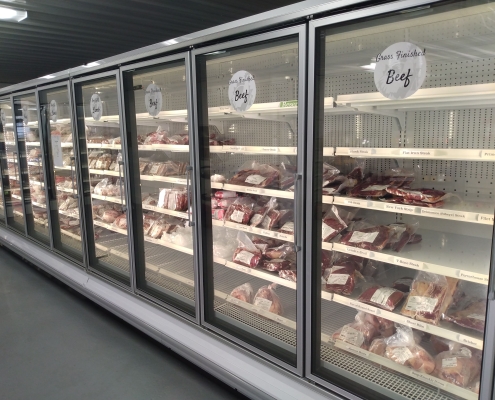How To Save Money on Groceries When Prices Are High.
Saving Money At The Grocery Store Is More Challenging Because of These Factors.
It can be hard to save money at the grocery store when everything is more expensive, and you still want to feed your family nutritious and delicious meals. According to the United States Department of Agriculture, grocery prices are expected to increase by 8% in 2023, and that’s on top of the 11.3% increase in 2022. Here are just a few of the elements affecting these price increases:
- Avian Flu: An avian flu epidemic badly hit farmers raising hens in 2022. Estimates range in the millions for the number of birds killed by the flu or to prevent the spread of the disease. Egg pricing is at a historical high of 60% over the previous year’s cost. This increase impacts the price of eggs to the end consumer and businesses using eggs in their processed or prepared foods.
- The War in Ukraine: Ukraine is one of the world’s top grain exporters, so when Russia invaded the country in 2022, prices for wheat and bread products skyrocketed by as much as 17.7%. Flour pricing is also up by 23%, affecting prepared foods and raw flour prices to the end consumer. Like Ukraine, Russia is a leading grain supplier and has seen its exports restricted in 2022 and 2023, which isn’t helping global prices.
- Unusual Weather Patterns: Weather patterns and disease continue to impact farmers and ranchers worldwide. Droughts and heat waves are affecting olive trees in Spain and Italy, reducing inventory for olive oil by as much as 50%. Lettuce is also being hit badly by disease and warmer temperatures that allow pests and diseases to thrive. Typically, cold frosts protect some produce from infestation, and currently, that’s not happening.
- The Supply Chain: Supply chain disruptions continue to impact the price and availability of food. The war in Ukraine is certainly a factor, but so are employment challenges faced by the agricultural, trucking and retail industries. Since the pandemic, the food industry has found it difficult to find and retain employees and even after three years, there are still persistent problems. Lower wages, increases in education, and immigration challenges impact the agricultural sector’s ability to harvest and process goods. According to AgAmerica, an agricultural financing provider, the agricultural industry saw a 7% decline in hired help and a 5% increase in wages in 2018 – and that was even before the pandemic! Additionally, the American Trucking Associations reported a shortage of 80,000 truckers in the U.S., adding to the supply disruptions we’re all seeing in the grocery store.
- Energy Costs: The war in Ukraine has also affected energy prices, which affects nearly every aspect of the food industry. Sanctions against Russia have reduced global energy supplies, but demand remains high. Less supply raises fuel and fertilizer costs while also increasing the cost of transporting food across the country. These increased costs are passed on to you, the customer, in the final price you pay at the grocery store.
Save More By Cooking At Home.
Growing up, we all heard our mothers say, “We have food at home!” when we asked if we could eat out––and she was right. Saving the most money on groceries starts with preparing food at home versus eating out or using a meal kit service. According to Forbes, it is almost five times more expensive to order delivery from a restaurant and three times more costly to use a meal kit service than to cook at home from scratch. Plus, cooking at home is healthier for your family and the environment. It allows you to use more nutritious ingredients with fewer preservatives while protecting the environment by reducing wasteful packaging.
These Tips Help Our Family Budget Grocery Prices Better.
We know many of you are frugal shoppers and here are some tried-and-true tips for saving money purchasing nutritious foods for your family.
- Buy In Bulk: It’s no secret that you usually save money when you buy in bulk. From canned goods, coffee and paper products, you can save as much as 40% on specific items. Consider purchasing whole animals from our family farm and stock them in your chest freezers to pull from all year. This allows the highest quality food at the best price point. Remember that you won’t save any money purchasing in bulk if you don’t eat or use the products, so make sure you’re only buying items you’ll actually use.
- Plan Your Meals: Do you ever wander around the grocery store and add items to your cart without considering the specific meals you plan to serve that week? We’ve probably all done it, but in our experience, you don’t save money using that method! Try sitting down during the week to put together an actual meal plan that works for your schedule. This helps save money, but it also eases stress when you know you’ve got a quick and easy meal planned for busy weeknight dinners.
- Choose Frozen Vegetables & Fruit: We love fresh fruits and vegetables, but they’re more expensive than frozen options – especially during winter. Stock up on fresh fruit over produce season, and freeze for use over the winter. Defrosted blueberries, peaches and strawberries are great on pancakes or over cereals and can even be transformed into smoothies by adding bananas and plain yogurt!
- Get Canning: Canning is a wonderful way to take advantage of fruits and vegetables when they taste the best and cost the least. Canned vegetables work wonderfully in soups, stews and rice dishes, while canned fruit can be integrated into oatmeal and even served in cobblers and crisps! Whether you’re canning fruits and vegetables you grew in your garden or picked up from the local farmers market, you’ll enjoy a healthier option than the canned items you purchase from the grocery store. Home canned goods typically have less sodium and sugar than canned items from the supermarket. Not enough time for canning? Keep an eye out for sales on ten cans for $10. When purchasing canned fruit, try to find options packed in light syrup or fruit juice to minimize excess sugars. For canned vegetables, look for low sodium or low fat options or rinse the vegetables to reduce sodium.
- Cook Dried Beans: There’s a reason that beans are such a prevalent ingredient in almost every culture’s cooking. They’re affordable and nutritious and can go in nearly anything. Start by soaking dried beans overnight and cooking them in the pressure cooker. Serve them alongside pork chops, roast chicken and lamb or even as the main course!
- Buy Local: By purchasing locally raised meats, eggs, honey and vegetables, you can avoid supply chain disruptions and save money! Lower transportation costs can mean lower prices for consumers shopping local meat markets and farmers markets.
Many In Our Community Need Help Feeding Their Families.
We hope you find our research and tips helpful in better understanding grocery prices and how to save money this year. Many of us are fortunate to be able to continue feeding our families nutritious meals, but some in our community are struggling. Check out these food pantries and organizations looking for donations in our community:
- Blue Ridge Area Food Bank: The Blue Ridge Area Food Bank is always seeking donations and volunteers to support their organization and the people experiencing food insecurity in our community. Check out how you can help their organization!
- Rejoicing Life Church: This Baptist Church works closely with the Blue Ridge Area Food Bank to provide food and clothing to those in need. Call or email for food pantry hours and how to donate.
- Potters House Praise & Word: This food bank is located in Stuarts Draft, VA and is typically open on Thursday mornings. Call before you visit to ensure operating hours are the same.
- Calvary United Methodist Church: This church maintains an active food pantry with open hours between two and five on Thursdays.
Want to learn more ways to save money on groceries and contribute to your local community? Contact our team!
Research:
(1) “Inflation is easing, but some grocery prices are expected to soar in 2023.” Accessed 01/23. <https://www.marketwatch.com/story/inflation-is-easing-but-the-prices-of-these-food-items-are-likely-to-soar-in-2023-11673501308>
(2) “Why These Supermarket Staples Are So Expensive Right Now.” Accessed 01/23. <https://www.cnet.com/personal-finance/why-some-supermarket-staples-are-so-expensive-right-now/>
(3) “2022-2023 Confirmations of Highly Pathogenic Avian Influenza in Commercial and Backyard Flocks.” Accessed 01/23. <https://www.aphis.usda.gov/aphis/ourfocus/animalhealth/animal-disease-information/avian/avian-influenza/hpai-2022/2022-hpai-commercial-backyard-flocks>
(4) “Salinas Valley farmers hit by lettuce virus.” Accessed 01/23. <https://www.agalert.com/california-ag-news/archives/november-9-2022/salinas-valley-farmers-hit-by-lettuce-virus/>
(5) “Here’s How Much Money You Save By Cooking At Home.” Accessed 03/23. <https://www.forbes.com/sites/priceonomics/2018/07/10/heres-how-much-money-do-you-save-by-cooking-at-home/?sh=2d534a8e35e5>







